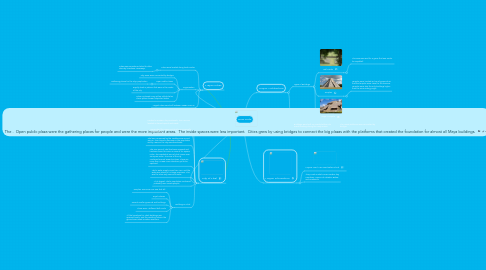
1. Mayan Information
1.1. Mayans Lived 1100 Years before Christ
1.2. They Lived in what is now modern day Honduras, Mexico, El Salvador, Belize, and Guatamala
2. Mayan Cities
2.1. Cities were located along trade routes
2.1.1. Cities were sometimes linked to other cities by limestone causeways.
2.2. Organization
2.2.1. City areas were connected by bridges
2.2.2. Open Public Plazas
2.2.2.1. Gathering places for the city's popluation
2.2.3. Royalty lived in palaces that were in the center of the city
2.2.4. Cities contained many pillars called Stelae. These pillers showed important dates
2.3. Largest cities were built between 250BC-900AD
3. Mayan Architecture
3.1. Types of Buildings
3.1.1. Ball Courts
3.1.1.1. This area was used for a game that was similar to raquetball
3.1.2. Temples
3.1.2.1. Temples were located on top of pyramids so that the temples were closer to the heavens. Temples were also the only buildings higher than the surrounding jungle
3.1.3. Royal Acropolis
3.2. Buildings were built on raised platforms to avoid flooding during the rainy season.
3.2.1. The raised platforms were connected by bridges.
4. City of Tikal
4.1. Located in modern day Guatamala. The ruins are located in dense tropical rainforests.
4.2. Dominated the region politically, economically and militarily
4.3. Tikal was conquered by the Teotihuacans around 400AD. This caused a decrease in the population and by 1000AD the city was abandoned.
4.4. The core area of Tikal has been mapped and has been found to cover an area of 6.2 square miles. The residential area of Tikal covers over 23 square miles. The core of the city contained around 3000 structures. There are more than 10,000 more structures yet to be explored.
4.5. Tikal's water supply came from rain- and the water was stored in 10 large reservoirs. This was the cities only source of water.
4.6. At its largest, Tikal's population numbered probably near 90,000 people.
4.7. Buildings in Tikal
4.7.1. Temples- some are over 230 feet tall.
4.7.2. Royal Palaces
4.7.3. Several smaller pyramids and buildings
4.7.4. There were 7 different ball courts
4.7.5. All the limestone for Tikals buildings was quarried locally- and the resulting holes in the ground were used as water reservoirs.
